#rhamphorhynchid
Text
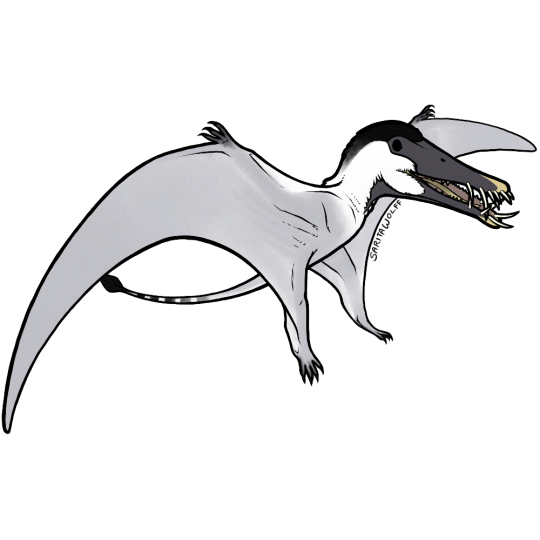
#Archovember Day 13 - Dorygnathus banthensis
Dorygnathus banthensis was a rhamphorhynchid that lived in the Early Jurassic of Europe, also in the time of the early Tethys Sea taking up most of the continent. (I did not realize I had put so many of these Jurassic archosaurs this close together when I made this list! We’ll be getting something from the Cretaceous tomorrow, don’t worry.) Like other rhamphorhynchids, it had a short neck, a long tail, and large interlocking fangs for catching and gripping wriggling fish. Wear on the teeth of some specimens suggest that they may have also fed on hard-shelled prey like mollusks and crustaceans. One specimen also contains preserved hairs, further evidence of pycnofibers or feathers in all pterosaurs.
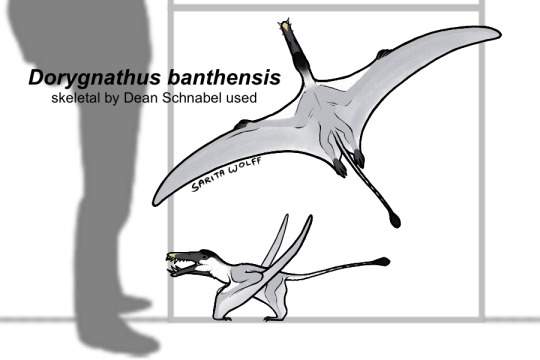
Dorygnathus was more common in its environment than its contemporary Campylognathoides, and both have been found in marine deposits suggesting they regularly traveled over open sea. Dorygnathus would have lived alongside our previously visited Macrospondylus bollensis as well as other teleosauroids like Mystriosaurus, Pelagosaurus, and Platysuchus. It would have come across sauropods like Ohmdenosaurus, and flown over the variety of Early Jurassic ocean life like icthyosaurs, small plesiosaurs, early sharks, ammonites, and much more.
#my art#SaritaDrawsPalaeo#Dorygnathus banthensis#Dorygnathus#Rhamphorhynchid#pterosaurs#archosaurs#archosauromorphs#Archovember#Archovember2023
22 notes
·
View notes
Text

Pterosaurs.

A closer look at Scaphognathus.
24 notes
·
View notes
Text
An experiment with pen.
Last year I decided to conduct an experiment. Its essence was to draw an animal based on a reference, but using only a pen when creating a sketch. As a result, I made these two drawings.

It is a rhamphorhynchid pterosaur Bellubrunnus rothgaengeri from the Late Jurassic of Southern Germany. It is known for a small individual less than a year old. Its characteristic feature is the forward-curving terminal phalanges of the fourth finger which supports a patagium. In the process of creating the drawing, I encountered difficulties in conveying the position of the left wing in space. I had to use white gouache and make corrections so that the drawing didn't look too distorted.

The second drawing is a megalosaurid theropod Dubreuillosaurus valesdunensis from the Middle Jurassic of France. There were much fewer problems with transferring the shape of the skull to paper, because I am more familiar with theropods as an object of drawing than with pterosaurs. In the previous case, the result was not bad, but I like this portrait more. :) Dubreuillosaurus is known from the incomplete skeleton of a 5 meters long immature individual. At first it was described as a species of the genus Poekilopleuron, but in 2005 it was separated as an independent genus.
Both drawings are made with black ballpoint pen.
#bellubrunnus#rhamphorhynchus#rhamphorhynchidae#pterosaurs#dubreuillosaurus#megalosaurus#megalosauridae#theropod#theropod lips#jurassic period#paleoart
4 notes
·
View notes
Text
Where and how did pteranodontians come to be?
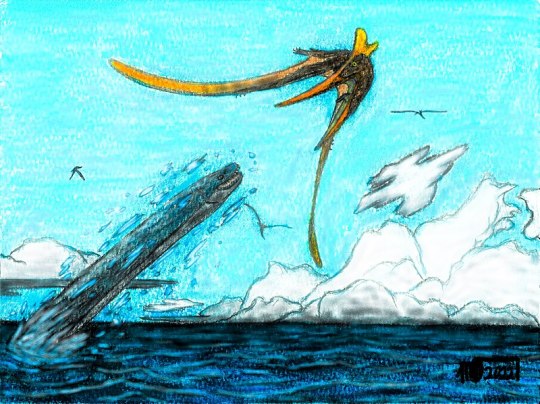
Epapetelo by SpinoDragon145
Pteranodontians are a famous clade of Late Cretaceous pterosaurs that include the titular Pteranodon, the nyctosaurs and taxa that sometimes are either pteranodontids or nyctosaurids like Volgadraco. They dominate the Late Cretaceous oceanic environments, seemingly replacing the closely related ornithocheiromorphs and other toothed piscivorous pterosaurs.
Strangely, they appear almost ad nihilo, suddenly bursting into the fossil reccord with no intermediary forms with other pterosaur groups. So, how did these pterosaurs evolve?
In most cladograms, they appear as sister taxa to Ornithocheiromorpha. Seeing as ornithocheiromorphs were around the earliest Cretaceous, this would suggest a ghost lineage of almost 50 million years. Unless early pteranodontians were small aerial insectivores or something, such a ghost lineage appears odd. It may however be corroborated by a Berriasian nyctosaur humerus (Naish et al 2010), assuming it is from a nyctosaur and not from a late surviving rhamphorhynchid (which had similar triangular deltopectorals) or something else entirely.
More likely is that these animals evolved much late and from within the Ornithocheiromorpha, which would make this group paraphyletic in regards to Pteranodontia. After all, both groups are dictated only by morphological traits (the relatively "primitive" ornithocheiromorphs lining together against the "derived" pteranodontians) and there's no way to get genetic analyses. An origin within Ornithocheiromorpha would lessen the degree of the ghost lineage and feel more "natural" than an extended 50 million year ghost lineage.
Within the Ornithocheiromorpha, I find the targaryendraconids to be possible ancestors, sharing upturned jaws with no crests, or alternatively the boreopterids, being freshwater taxa that would have easily survived the Cenomanian mass extinction.
Only further fossils will answer for sure.
12 notes
·
View notes
Photo
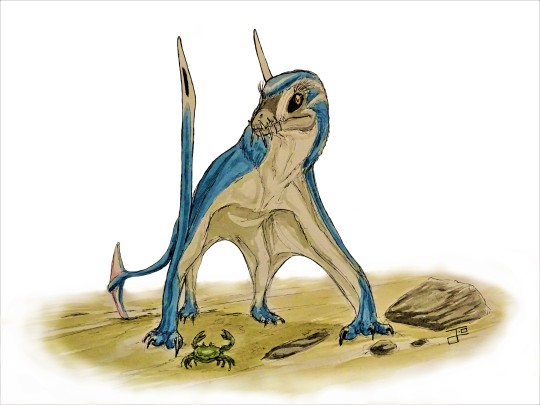
I didn't initially get round to illustrating the recently-described Scottish pterosaur, Dearc sgiathanach, so what better day for a watercolour sketch of this impressively large Jurassic rhamphorhynchid than St Andrew's Day!
102 notes
·
View notes
Text
Codex Entry #002 | “Radon kashiwagii” (Rodan)

[This Series is heavily inspired by Trollmans’ “FOLLY OF MAN” series on DeviantArt, so be sure to follow him if you enjoyed my work]
Species: Radon kashiwagii (Rodan)
Subtitle: The Fire Demon
First Modern Sighting: December 26, 1956
Height: 111.43 Metres
Wingspan: 275.082 Metres
Weight: 42,634.601 Tonnes
It is currently believed that the Rodan species diverged from rhamphorhynchid pterosaurs sometime in the Mid-Jurassic. It is believed that its ancestors nested within volcanoes and gradually developed a bio-volcanic nature through bursts of G-radiation occasionally emitted through underground caves and tunnels within these volcanoes. As with most kaiju, the cell structure of rodan are similar in shape and function to G-cells, though there are many key differences. It is theorized that these creatures feed off of radiation like the Godzilla species, though this appears to be far less efficient being done through their lower wings and middle crest. So far, most specimens found have been adolescents (pictured above). Few juveniles have been found, they seem to exhibit far brighter colors and lack any form of storing or releasing radiation. Due to this, the young form large flocks and have been known to hunt small whale species. Rodan become darker as they age, which may hypotetically culminate in a near pitch-black full-grown form.
Rodan exhibit corvid-like levels of intelligence, and can replicate many sounds. Documents exist of Rodan mimicking the sounds of whales, fog horns, earthquakes, storms, and even other kaiju. It’s additionally been discovered that the species are able to communicate with other species through a variety of vocalizations and gesturing.
Due to the large size and high speeds of rodan, their flight causes supersonic shockwaves that can cause Tsunamis and even topple skyscrapers when flying low.
Rodan seem to be preyed upon by other kaiju and have developed numerous offensive and defensive capabilities as a result. They’ve learned to expel radiation through their mouths creating scorching “heat beams” akin to godzilla’s atomic breath. The species has also learned to create distortions in the air, manipulating the electric charge of surrounding atoms which creates an effect somewhat similar to that of volcanic lightning. They combine these two attacks together to create a devastating attack dubbed “volcanic lightning rays”.
Due to the bio-volcanic nature of Rodan, their inner organs can reach temperatures of nearly 1’300 degrees Celsius. Though their body insulates most of this heat, it is still vented through their lower wings to prevent internal combustion, allowing for a trail of potential airborne ash and magma to be released during flight.
The underbellies of Rodan are also covered in layers of spiked plating to protect against attacks from below.
I hope y’all liked my Rodan codex entry for GODZILLA: Age of Monsters. The story post will be combined with that of another kaiju who’s artwork will be begun soon…
Tune in for more updates and future posts. Peace and love! ✌️🏽
#kaiju#godzilla#gojira#godzilla au#art#artwork#kaiju redesign#godzilla: age of monsters#godzilla fanart#rodan#kaiju art#long post
15 notes
·
View notes
Text

GODZILLA: DOMINATION!
RADON
Artist's commentary: too many full red/orange rodies out there. AND too many dsungaripterid-based rodies too. Have here one that is neither of the above. Based on a Heisei-generation concept art, and on rhamphorhynchids, and maybe some seabird for the face.
9 notes
·
View notes
Photo

Rhamphorhynchus 01
Late Jurassic, Europe
A pair of Rhamphorhynchus pterosaurs in the first light of dawn.
Made in Blender.
#paleontology#paleoart#pterosaur#Jurassic#late jurassic#Rhamphorhynchus#rhamphorhynchoid#rhamphorhynchid#pycnofibers#dawn#dusk#Nathan E. Rogers#blender#3d#prehistoric#solnhofen
36 notes
·
View notes
Photo

oh goose?
updating my goose sona; he is now a little bit less goose and a little bit more Bastardous
also they have goose wings still; im just lazy and didnt feel like drawing feathers
#anthro#clean furry#fursona#sona#goose#he goose/rhamphorhynchid/baboon cross#aka a fucking wierdo#goose sona
12 notes
·
View notes
Note
I noticed all the pterosaurs in PP were the toothless short-tailed variety. Did the long-tailed toothy ones already die out by the late Cretaceous?
Yep, and not just the long-tailed toothy pterosaurs, but almost all pterosaur groups seem to have gone extinct before the end of the Cretaceous! The only remaining pterosaurs (that we know of) were all pterodactyloids, or "short-tailed" pterosaurs. Most pterodactyloids did also have teeth (like Pterodactylus itself for example), but by 66 million years ago only two groups were left, both toothless, and those are the ones that show up in Prehistoric Planet.
There's Pteranodontia, which includes Nyctosauridae (represented in PP by Barbaridactylus and Alcione) and Pteranodontidae (represented by Tethydraco).

And there's Azhdarchidae, which is represented in Prehistoric Planet by Phosphatodraco, the unnamed Mongolian azhdarchids, Quetzalcoatlus, and Hatzegopteryx.

The long-tailed toothy ones used to be grouped together as "rhamphorhynchoids", but this is an unnatural grouping that lumped together early pterosaurs, dimorphodontids, anurognathids and rhamphorhynchids based on them being seen as "more primitive". It's not really a scientifically useful group, but yeah by the Maastrichtian stage of the Cretaceous everything that wasn't a pteranodont or an azhdarchid seems to have been gone.
#prehistoric planet#prehistoric planet spoilers#pterosaurs#paleontology#paleoart#paleomedia#palaeoblr
183 notes
·
View notes
Text

#Archovember Day 10 - Megalosaurus bucklandii
Megalosaurus is famous for two things: being the first non-avian dinosaur described and the basis for establishment of the clade “Dinosauria”, and being one of the first “life-size” dinosaur models ever created. Megalosaurus’ inclusion in the Crystal Palace dinosaur model collection greatly increased public interest in dinosaurs, though they certainly did not know much about its life appearance at the time. Most people now know how laughably inaccurate those models were (but hey, they were trying, it was the first time paleoartists had tried to reconstruct an animal from bone fragments!), but not many know about the real animal behind the dino-hype.

Megalosaurus bucklandii lived in Middle Jurassic England. It is the type species of the Megalosaurids, one of the first major radiations of large theropods, and was generally robust and muscular with powerful hind legs, though not as much as its relative Torvosaurus. While all specimens of Megalosaurus are fragmentary, it seems to have had an unusually large head, equipped with a powerful bite built for holding on to struggling prey. Unfortunately, due to the fragmentary nature of this dinosaur’s fossils, we do not actually know much about its life appearance! Most of what we know must be inferred from other Megalosaurids. That being said, while feathers seemed to have been rare in Jurassic theropods, the Late Jurassic theropod Sciurumimus was preserved with traces of feathers. Sciurumimus is thought to be a juvenile Megalosaurid, though this is disputed. So it could go either way, though it was probably not as heavily feathered as the future Cretaceous theropods would be.
As England was broken up by a series of small islands in the Middle Jurassic, Megalosaurus probably used its muscular hind legs for swimming from island to island in search of prey, which it was also well equipped to chase down. As the apex predator of this environment, Megalosaurus would have had its pick of early sauropods like Cardiodon, Cetiosaurus, and Cetiosauriscus, small theropods like Iliosuchus, early stegosaurs like Lexovisaurus, rhamphorhynchid pterosaurs like Klobiodon, marine pseudosuchians like Teleosaurus, small mammals like Amphilestes and Amphitherium, all the way down to washed up fish or crabs along the beach. It would have lived alongside, and possibly competed with, other large theropods like Cruxicheiros and Streptospondylus, though Megalosaurus appears to have been the most common of the three.
#my art#SaritaDrawsPalaeo#Megalosaurus bucklandii#Megalosaurus#Megalosaurid#theropods#saurischians#dinosaurs#archosaurs#archosauromorphs#reptiles#Archovember#Archovember2023
16 notes
·
View notes
Text

Rhamphorhynchus! It looks like it's going "YIPPIEEEEEE!"
13 notes
·
View notes
Photo

It's been a while since I've drawn any dinosaurs, hasn't it? Time to rectify that.
This is a small collection of animals from the Hell Creek formation, for the most part. A few of them are a bit iffy, like the alvarezsaur and the rhamphorhynchid. Come to think of it, I think the latter went extinct in the Jurassic. The reference used was Saurian's Field Guide to Hell Creek, but I wasn't aiming for the absolute most accurate. Just something to keep my hand in after a little dip.
From top to bottom using their heads: a juvenile Tyrannosaurus, Thescelosaurus, an ornithomimid, Acheroraptor, Didelphodon, Palaeosaniwa, Pachycephalosaurus, an alvarezsaur, Anzu, big ol' frog, Champsosaurus, Pectinodon, a bord, Triceratops, and Denversaurus.
Like the Underdark monsters, there's also a transparent version as a sort of coloring page, if you'd like here. Just make sure to tag me so I can see it!
#dinosaurs#dinosaur#paleontology#hell creek#hell creek formation#tyrannosaurus#thescelosaurus#ornithomimus#ornithomimid#acheroraptor#didelphodon#palaeosaniwa#Pachycephalosaurus#alvarezsaur#anzu#champsosaurus#pectinodon#triceratops#denversaurus
10 notes
·
View notes
Text
Have you heard the tragedy of rounded wingtips the wise?

Pterosaur wing diagram by Federico Benzan. This was on Wikipedia’s pterosaur page for the longest time… until someone noted them paddle-shaped wingtips….
Recently a controversy (which I’m using the broadest definition of the term since this hasn’t actually caused any significant drama) revolving around the maxim that pterosaurs have rounded wingtips has erupted on twitter. World renowed paleontologist and actually-legitimate cryptozoologist Darren Naish has noted that there has been an emphasis on “rounded wingtips” when describing and depicting pterosaur wings in modern paleoart; upon a response from Dave Hone (whoch has published the paper responsible for this) this has evolved in a broader conversation about wing membrane lobes and the actual shape of the pterosaurian distal phalange.
TL;DR: pterosaur wing tips were rounded to some extent… but also not.
What is “pointy” actually?

Examples of alleged modern pointy wings, a frigatebird (putneymark) and a Mexican free tailed bat (jabz photography). Note that in both cases the sharpness of the wing is undermined by different segments (feathers and cheiropatagia respectively) that still blunt the terminal profile. Pterosaur aktinofibrils apparently did the same.
First of all, lets get a few things straight:
The Dave Hone paper linked above that started this whole thing doesn’t explicitly make a pointed wing an impossibility, just unstable and stupid. Natural selection doesn’t operate on intentional perfection, so a “subpar” design can still exist if it doesn’t flat out damage an animal’s survival. Thus, a pterosaur with pointy wings could hypothetically still fly, just not as well as one with a stable rounded wingtip.
That said, there is evidence that most pterosaurs had terminal phalanges that were curved to some degree, so this selective pressure is evident on the fossil reccord, though not universal (see below).
Darren Naish doesn’t dispute the presence of some roundness (though he clearly favours a minimalistic take on that). What he is mostly concerned with is what he calls a “convex lobe”, a section of the membrane projected that blunts the wing shape.
With that out of the way, we are left with two main issues:
Are pterosaur wings universally blunt? Or are there exceptions?
Was there evidence of a lobe?
The former is already semi-addressed: most pterosaur wings have curved end phalanges, as the paper demonstrates. HOWEVER, this actually doesn’t seem to be universal: in rhamphorhynchids at least, the terminal wing phalanges seem to be pointy, and in the case of Bellubrunnus they actually do the opposite of most pterosaur phalanges and curve outwards.
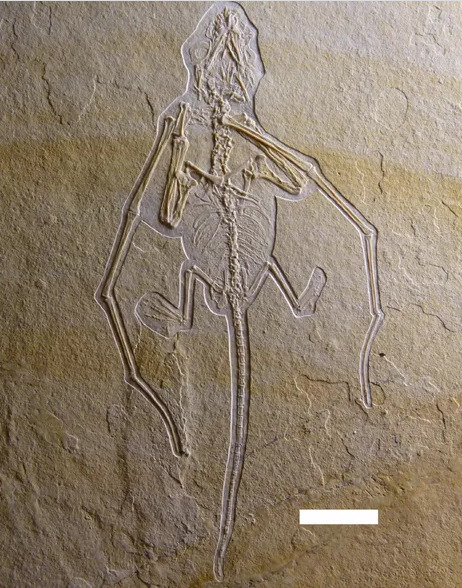
Bellubrunnus by Dave Hone. Notice pointy wing phalanges.
So yes, for whatever reason rhamphorhynchids and a few other groups gave this trend the wingfinger. However, they are the exception that proves the rule, as they are considered aberrant for this.
Onto the next point, the presence of a lobe. I think we can safely argue against the massive lobes seen in some diagrams like the article opener, but Darren Naish actually argues against even small lobes like in this reconstruction of Bellubrunnus:
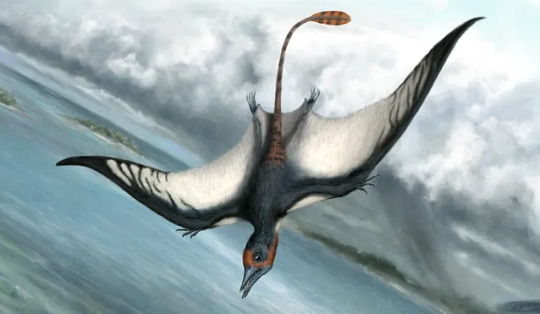
By Matt Van Rooijen.
This I have to disagree with. Abundant studies have some that the distal section of the wing membrane of pterosaurs was full of rigid aktinofibrils (Witton 2013, th aofrementioned Dave Hone paper), so it was clearly an adaptation to generate a more rigid membrane in this area. While this does not prove the existence of a large lobe, it does make the existence of a small degree of convexity, certainly enough to at least smoothen the terminal wing in conjunction with the curved phalanges.
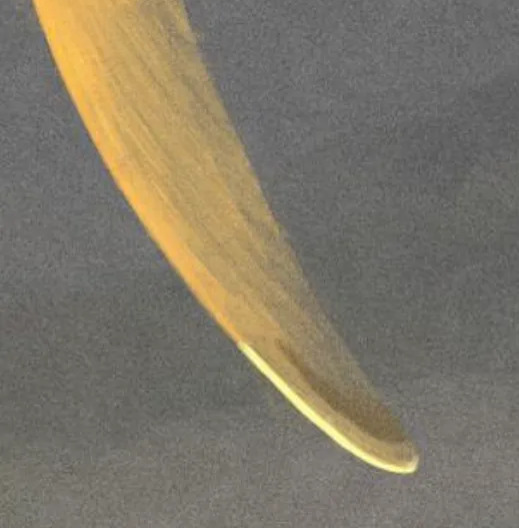
Muzquizopteryx wing end by John Conway. The artist has largely popularised rounded wing tips by emphasising the curved phalange with just a little bit of soft tissue trailing, which I think is a good, plausible compromise.
Along the way some people on twitter used examples of alleged pointy wings in modern animals like some seabirds and bats. However, in both cases the “sharpness” of the wing is severely undermined:
In most birds, flight feathers have round distal margins. Additionally, they form the wing in multiple segments; if one feather is damaged, others can make up for it. They certainly did not have a bony element sticking out as in the “pointy pterosaur wing” model. In fact, I find pictures of birds with fully sharp wings to be fairly rare, with even triangular winged species like falcons and frigatebirds usually having splayed feathers at some point in their flight cycle.
In bats, the wing is inherently rounded due to the presence of multiple wing fingers. Sharp wing fingers are by themselves rather rare in healthy specimens — they’re emmersed in membrane, hence why they lost their claws — at most you have species where the third finger is particularly elongated as to form a subtriangular wing. Like pterosaurs they have specialised fibers (in their case muscle groups) that prevent fluttering and maintaing the membrane’s shape in flight.
So yes, I think pointy wings are biologically inaccurate and evidence points towards at least somewhat round wing tips. But not too round, as large convex lobes are absent.
Prehistoric Planet
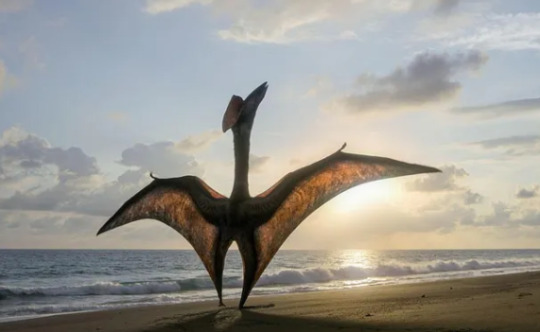
Prehistoric Planet azhdarchid model. Since this is a teaser picture I’m assuming it is okay to use.
This controversy has come just in time for Prehistoric Planet’s release, easily the most spectacular prehistoric documentary to date. Since Darren Naish and Mark Witton had creative control on pterosaur wings, how do they fare?
In pteranodontians, they are in fact rounded. Not too rounded, but a combination of curved phalanges and some soft tissue trailing make them more in line with the modern paleoart trend.
Azhdarchids, on the other hand, have extremely pointy wings. This makes less sense to me because they were inland flyers, which tend to have broader wings, though their distal phalange curvature is less pronounced so a large convex lobe would be necessary to create their rounded wingshape.
Overall I’m satisfied with the results, but I hope the discussion continues, especially since some people are naturally being imbeciles and going the opposite direction.
8 notes
·
View notes
Photo

My 2019 art in review:
Jan - Yellow Submarine fanart
Feb - 3D Sphynx model for uni
Mar - The Last Guardian fanart
Apr - The Last Guardian fanart
May - Sonic the Hedgehog redesign
Jun - Working on dissertation
Jul - Working on dissertation
Aug - Earthbound fanart (incomplete)
Sep - Pet portrait request
Oct - Serval illustration
Nov - 3D Rhamphorhynchid model (incomplete)
Dec - Pet portrait request
#art#my art#2019#2019 year in review#2019 year in art#2019 art summary#artof2019#lazert#lazer-t#yellow submarine#sphynx#3d model#the last guardian#sonic#sonic the hedgehog#earthbound#ness#mother 2#corgi#cat#serval#rhamphorhynchus#dog
32 notes
·
View notes
Text


WEEK 20: KONGAMATO
I'm still at it! It, in this case, is the Crypt-A-Long, a tribute to the cryptids of the world styled after the annual Geek-A-Long blanket from Lattes and Llamas. Pop on over to their website for instructions about how to knit and assemble the squares, then come back here for more cryptids than you can shake a very mysterious stick at.

In the words of Jonah Heston, the Congo's Kongamato is a mondo flying dino, I know I don't wanna die but when I do he'll be the guy. I like a man who takes the time to plan his own death by cryptid. The Kongamato was supposedly encountered by a series of explorers in the Jiundu swamp area in the first half of the 20th century, and described as a red bird- or bat-like creature resembling a rhamphorhynchid pterosaur. Not a lot is heard about it these days, suggesting it is either extinct or never existed in the first place.

18 notes
·
View notes